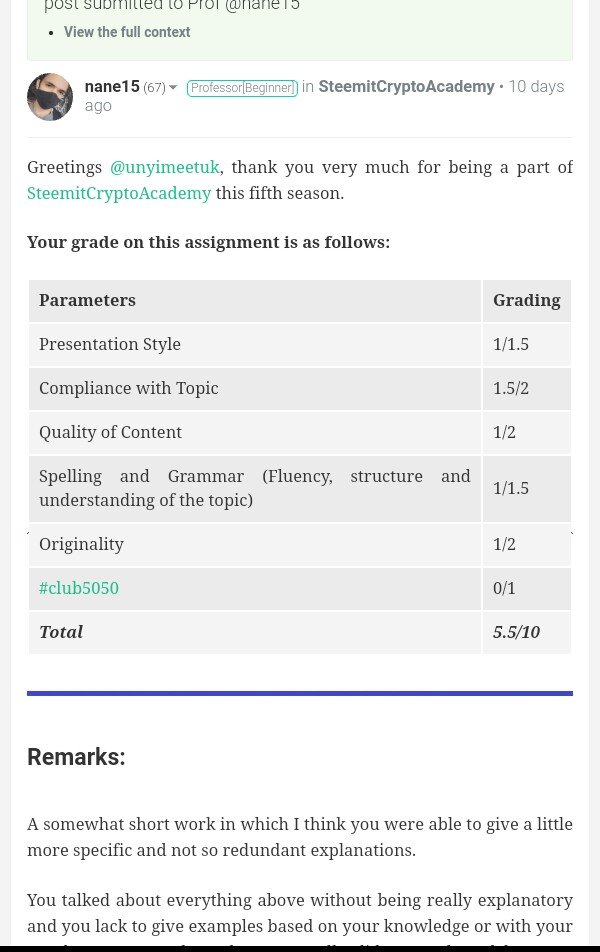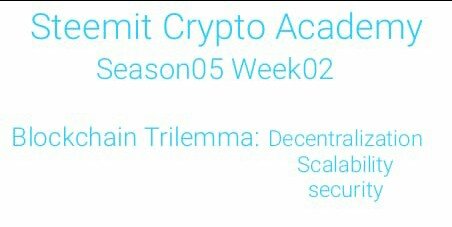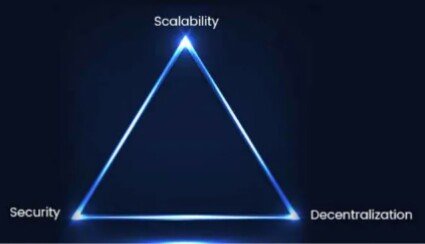REPOST: Blockchain Trilemma - Crypto Academy / S5W2 - Homework post submitted to Prof @nane15
Hello Prof @nane15,
My S5w2 assignment was not upvote.
Please, here is the link Blockchain Trilemma - Crypto Academy / S5W2 - Homework post submitted to Prof @nane15
My score
Explain in your own words what the Blockchain Trilemma is
Digital currencies operate on a server called Blockchain. This server is decentralized in operation. Which means that several independent nodes play an equal role of data management, unlike it counterpart, which is centralization. Blockchain technology have eradicated limitations of using centralized. Which are; fast, cheap, immutable.
To actualize the benefits of using blockchain, three major issues are involved. These issues birth a term known as trilemma.
The term Trilemma means a condition of encountering three undesirable issues. In this situation, the three issues are very important, but one have to choose the most preferable.
In blockchain technology, blockchain trilemma, means the three major problems that blockchain programmers confront when developing a blockchain network. These difficulties are; security, decentralization and scalability. During the confrontations, blockchain programmers are left with no option than to choose the two most vital options and trade-off one as the three options can not be accomplished at the same time viz; security and decentralization can be the programmer(s) choice and scalability will be trade-off. Vitalik Butterin, a Russian-Canadian programmer and co-founder of Ethereum blockchain, coined this term.
Decentralization
Instead of been controlled by a central node, the network must spread it data to several nodes simultaneously. This helps the blockchain to offer it participant equality in operation.
Scalability
The blockchain network should be able to perform numerous data transactions within a short duration and without increasing transaction fees.
Security
Blockchain should be invulnerable. This will prevent the network from hackers or any malicious issues that may affect it.
Since the advent of blockchain network technology with bitcoin and ethereum been the leading network, various programmers have put all efforts to develop a network that will solve the three issues completely without trading-off one, yet the problem is incompletely resolved.
Is the Blockchain Trilemma Really a Trilemma?
The blockchain trilemma is not really a trilemma. It is a term that create an awareness of the three mandatory issues that blockchain developers should be considering.
The emergence of new blockchain technology have proven that the problem can be solved without trading-off one, although they have not been completely eradicate it.
In security and decentralization, the blockchain have remained secured through the help of it private key and spreading of it data to several nodes hence, eliminate it control by a single server.
Blockchain networks such as polkadot network, Solana network and Cardano network etc. have attempt to solve the scalability limitations.
Define the following concepts in your own words:
A. Decentralization
B. scalability
C. Blockchain Security

Decentralization
This means the distribution of power and decision to multiply networks.
This is the core method of governance that the blockchain network use to manage it data. In a decentralized network, there is no need for a third party interference.
When a blockchain network is set up in a decentralized way, its data remain transparent to any node that is connected to the network and each node remains a witness of the data sent to the network. A shut-down of one node does not affect the operation of a decentralized network.
Scalability
This is another vital feature of a blockchain network. Scalability means the ability of a blockchain network to verify a several transaction within a short time frame. This implies that the greater a scalability of a network, the greater the number of transactions verified. That’s why most networks tend to limit it level of decentralization.
The scalability of any network depends on the number of nodes that validates it block. That’s why some network usual limit their rate of decentralization.
Currently, EOS network is the most scalable network. It can perform millions of data transactions within a second without any gas fee compare to Bitcoin blockchain. Scalability challenge is one of the limitations of decentralized network unlike centralized network.
Security
Blockchain security refers to it immunity to malicious attacks. In Decentralize Finance (DeFi), there have been records of various malicious attacks by hackers. The more secured a blockchain network, the greater the level of trust.
An attack on a single server does not alter any data as they are spread to several nodes.
To achieve a very secured network, decentralized means of data management must be use, that’s why blockchain is very secured compare to a centralized network.
A typical example is the bitcoin security. In order to attack it, the initiator must possess a minimum amount of 51% control of nodes that validate blocks. This process is highly expensive, hence considered impossible.
Base on your knowledge, explain at least two viable solutions to the challenge posed in the blockchain trilemma

Blockchain Trilemma can be solve by using the following methods;
Layer one
This layer helps the blockchain to accomplish scalability and strong security in a decentralized network. The method applied by layer one are;
Advancement of consensus mechanism: Blockchain networks that use Prove of Work (PoW) have scalability challenges of blockchain trilemma. A typical example is Bitcoin (฿). The cons of Prove of Work consensus mechanism is high security but since it a phenomenon that everything must have both pros and cons, as such slow scalability remains the con.
In PoS, miner are determined base on their staked token on the network at that particular time, unlike Prove of Work in which every miner battle to be the first to solve complex cryptographic algorithms.
The challenge of scalability has force the Ethereum blockchain to apply Prove of Stake (PoS) consensus mechanism in it recent upgrade - Ethereum 2.0.
Since it adaptation, it has increased the scaling speed and security yet still, applying decentralized principles.Shading: In layer 1, this means the breaking down of data transactions into small unit that are regarded as shardes. In shard, node share certain blocks of data and maintain it consistency rather than compacting the entire data (from genesis block to present block) on the server.
Currently, Tezos blockchain, Zilliqa blockchain, Qtum and Ethereum 2.0 are the blockchains that dominate the use of this method.
Layer two
In this layer, a secondary network is generated upon a primary one in order to eliminate the setbacks of the primary blockchain. The method applied by layer two are;
Blockchain nesting: Here, some data are transferred from the primary blockchain to the secondary blockchain in order to reduce traffic on the primary blockchain. This also improves security and scalability, and still maintains it decentralization.
Developing of sidechains: Attaching a sidechain to mainchain of a blockchain network is another unique way to solve blockchain trilemma. Sidechain data transactions must still remain transparent and used for validation as well. The mainchain will still play a role of maintaining the overall security. A dereliction in the sidechain should not affect the main chain.
State channels: This is the use of double-way data communications between off-chain and the blockchain. A typical example of this network are; Celer, Ethereum’s Raiden etc. Using the trilemma technique of trading-off an option, state channel sacrifice certain rate of decentralization to accomplish scalability
Conclusion

The trilemma of a blockchain have present challenges in adoption of the network. Over the pass decades, developers have battle for simultaneous balance of performance in decentralization, security and scalability.
However, the birth of layer 1 and 2 technique have help in minimizing the trilemma challenges. The use of Prove of Work which several nodes are given opportunities to validate yield a low scalability but increase it level of security. Prove of Stake adoption reduces the number of nodes as the highest stake handle the block validation.
I am pessimistic that with few years to come, blockchain trilemma will be completely eradicate because recently created blockchain network are gradually combatting the issues.




Hello prof @nane15
Please, attend to me, thanks